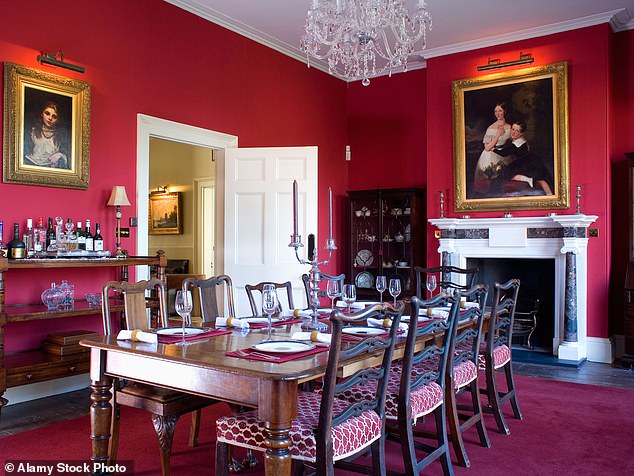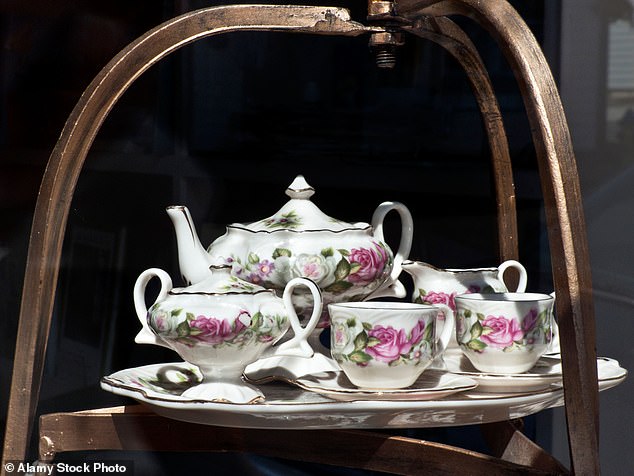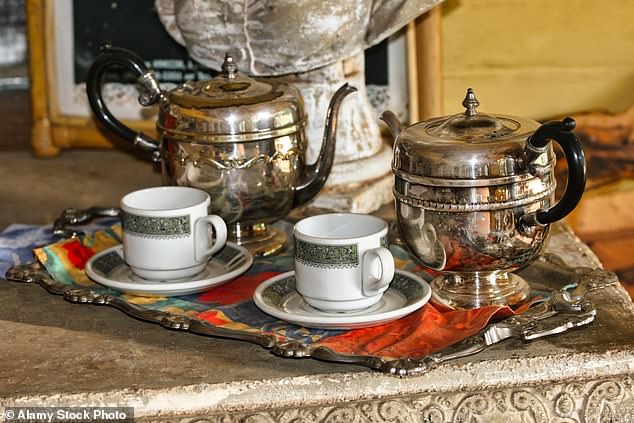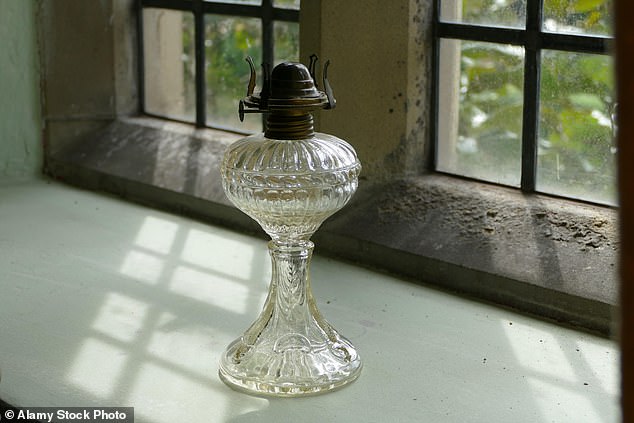Many of us have antiques, heirlooms or collectables proudly on display or carefully stored away at home that we hope are worth a bob or two.
But experts say many of the treasured pieces you or a family member spent thousands on decades ago may not have delivered the returns hoped for. In fact, some of the most popular antiques have not increased in value at all for more than 40 years – representing a staggering loss in value in real terms. In some cases they are worth less now than they were then. Here are common ones that may hold a place in your heart – but have very little value on today’s market.
Mahogany, oak, rosewood and walnut furniture
Popular antique furniture is perhaps the starkest example of a poor investment piece.
Mahogany, rosewood and walnut dining tables, chairs and cabinets are worth only a fraction of what was paid in the 1970s and 1980s.
Douglas Carter, owner of Alice’s antique shop in Portobello Road, London, explains: ‘House prices are now so expensive that people these days can buy a flat for £1.5 million and still get just a tiny little matchbox. You just can’t put a big mahogany dining table in there because it’s going to take up half the house.’

Mahogany, rosewood and walnut dining tables, chairs and cabinets are worth only a fraction of what was paid in the 1970s and 1980s
Nadine Okker, a dealer in Alfies Antique Market, says high quality rosewood dining tables used to fetch around £4,000 with a set of dining chairs around £1,500 in the 80s and 90s. In today’s money that would be around £17,000 for the table and £6,500 for the chairs. But Ms Okker says they are only worth a few hundred pounds now and that’s if you can find a buyer.
So in real terms, a table that sold now for £300 would have lost 98.2 pc of its value since 1980.
Smaller side pieces such as davenports – small compact writing desks – that used to sell for £700 to £800 are now usually only worth around £100, says Robert Barham of Barham Antiques in London.
Bookcases that were sold for £500 can be bought for £50 at auction now. Oak chest of drawers and desks worth hundreds in the past may only sell for £20. Only the rarest and best pieces have kept their value. ‘They don’t sound like a good investment, but you can fill your house with furniture that will last the rest of your life for just a few hundred pounds now,’ adds Mr Barham.
Another antique shop owner on Portobello Road, Judy Fox says: ‘A friend of mine put his entire furniture collection on auction and thought he could get around £80,000. He only managed £6,000.’
Porcelain dining and tea sets

Antique porcelain sets no longer sell as well as they used to and even sets from Royal Doulton may only fetch around £30
The prized dinner service given as a gift to your parents or grandparents on their wedding day may also be worth very little.
‘My shop used to be 90 pc porcelain’, says Ms Okker, ‘but I’ve got barely anything now because it just doesn’t sell.’ She says that high end China made by KPM – a German brand which translates to Royal Porcelain Factory Berlin – used to sell for around £500 per plate but can barely reach £200 now.
British antique porcelain sets made by Royal Doulton could sell 30 to 40 years ago for around £100 to £120. Now, you would struggle to get just over £30, says Mr Barham.
Silverware
Victorian silver plate tea sets, seen in popular period TV shows such as Downton Abbey, have seen a significant drop in value with one caveat: solid silver sets have and are always likely to keep up with the price of raw silver.

In general Victorian silver tea sets have seen a drop in value but solid silver sets have and are always likely to keep up with the price of raw silver
While silver was worth £6.50 an ounce in May 2007, it is £25 an ounce now, so a solid silver tea set with trays and teapots could still be worth its price in weight, if it fails to sell as an antique.
Silver plate on the other hand is worth far less. A Victorian silver- plated teapot was worth a few hundred pounds in the 80s and 90s, according to former antique silver dealer Matteo Lombardi, but is now only worth £10 to £50. Antique silver cutlery sets with ivory or tortoise shell have lost almost all their value because of legislation that bans the sale of these items.
Clocks
These were once an essential household item, but they have been in decline with the rise of mobile phones and digital clocks on household appliances. Buyers have gradually moved away from antique clocks, especially grandfather and mantel clocks.
Households may have saved for months to buy a beautiful grandfather clock and even 40 years ago an antique one could have sold for £1,500. But according to Mr Barham, they are ‘so out of fashion that you’re not going to get more than a few hundred quid, if that’.
Candlesticks
As antique candlestick holders have fallen out of use and fashion, their price has fallen.
Mr Carter, from Alice’s, used to be able to sell a pair of brass candlestick holders for more than £250 in the 1970s (£3,418 in today’s money) to clients in the US in particular. Now, however, he says that in terms of value alone, it would be better to scrap the candleholders for metal rather than trying to sell them.
Collectable figurines
The popularity of antique collectable figures such as bisque figurines has fallen in value as households opt for a more minimalist aesthetic, says Mr Barham. His father’s collection of bisque figurines was worth £500 to £600 per item in the 1970s to 80s but now says it would be difficult to sell them for more than £100.
Similarly, Victorian Staffordshire dog figurines are now only worth £80 to £90 for a pair, compared to the £200 the pieces commanded in the 1980s, according to Mr Carter. That £200 would be £856 in today’s money – an 89.5 pc loss in value.
Glassware

Antique dealers say that most vintage glassware, such as ornate wine glasses, are difficult to sell
Antique dealers say that most vintage glassware, such as ornate wine glasses, are difficult to sell. Ms Okker says that while Victorian glassware used to be valued at around £25 a glass, she would struggle to sell them now for £5.
While previously these glasses were used for special occasions, Ms Okker says they have fallen out of fashion. Intricate items such as glass epergnes – pieces used to display flowers or dispense sweets in a table service, have gone from around £500 to £600 in the 1980s to about £100 now, and only if people want them, says Mr Barham.
Wooden writing boxes
Victorian and Edwardian boxes made of walnut or mahogany were once used to store stationery on a writing desk. But as the need for handwriting diminishes, so has the demand for these beautiful boxes.
Mr Barham says that a good quality writing box would have sold for £200 to £300 in the 1980s and would be worth almost the same now. In today’s money, that £300 in 1980 would be worth £1,283 now. In other words the real value of a writing box has fallen by 76.6 pc.
Teddy bears
Your favourite fuzzy friend may still hold some value, if not as much as it used to. According to Daniel Agnew, who ran auction house Christie’s teddy bear auctions, prices of antique teddy bears rocketed in the 1990s and 2000s, but have since fallen.
He says a 16in Steiff bear in good condition would have been worth around £400 to £500 in 1980 but by 1995 they were about £1,500 to £2,000. This has since fallen to around £1,000 to £1,500.
The rarest and most sought after bears are those from 1905 to 1920, so these are the most likely to have kept their value, according to Mr Agnew. Those produced after 1945 have seen the greatest drop off in value due to their abundance in online marketplaces such as eBay.
Standard lamps
Antique standard lamps – also known as floor lamps – have lost out to their modern successors.
Standard lamps in either brass or wood with silk lampshades from the 1930s to 1950s used to be worth around £200 in the 1980s, (or £855 in today’s money), according to Ms Okker. They would now struggle to fetch £100.
What hasn’t lost value?
It’s not all doom and gloom in the antiques business.
Mr Carter says: ‘The hottest antique right now is advertising paraphernalia. It’s for people who are a bit older, have a man cave, and they put up signs that offer a bit of nostalgia.’
An advertising sign that may have sold 20 years ago for £165 to £175 could now be worth more than £2,000, he adds.
Antique taxidermy has also increased in value. ‘Strangely, a good taxidermy – fish, for example – has gone up in value massively,’ says Mr Carter. ‘Pieces I bought for £120 a few decades ago are worth nearly £1,000 now.’
While not technically antique, Mr Lombardi says the vintage watch market is still thriving. A 1970s Omega Speedmaster could be bought for £250 in the 1970s and 80s. It could now be worth more than £5,000.
Brands such as Rolex continue to fetch high prices despite a recent cooling in the market.
Rare and strange items will always have a market, according to experts. They recommend having an item valued if you think it may be worth something. ‘You just need two people to want something at an auction and it’ll make money. Sometimes it’s just down to luck,’ says Mr Barham.
Why have antiques lost their value?
Antique dealers cite various reasons why the market is not what it once was, but one reason resonated across the board: antiques are simply no longer in fashion. ‘The main thing to remember about the antiques business is that it’s fashion. That’s all it is,’ says Douglas Carter.
‘People now want clean looking sideboards and a minimalist living room. Hopefully antiques will come back into fashion, but I’m not sure they ever will.’
Despite being the world’s largest exporter of antiques, the UK’s export market has almost halved from a high of $1.3billion in 2019 to $669 million in 2024 based on antiques that were more than 100 years old, according to the UN Comtrade Database, a global trade data platform.
Antique shop owner Judy Fox says: ‘The trouble is that 30 years ago we would sell to Europe and America. Now you can’t sell to Europe because, firstly, they don’t want what we sell, and secondly Brexit is a hindrance. Now with America and the tariffs, that’s another big hindrance.’
The cooling of demand from abroad has lowered the price of antiques at home and will affect how much you can get for your prized possessions.
Mr Barham points to the shrinking size of homes in the UK. ‘As houses get smaller and smaller over the years, people just need smaller, simpler bits of furniture – stuff you can get measured to the inch from Ikea,’ he says.
British homes are 20 pc smaller than they were in 1970, according to Which? The consumer watchdog
This may have shifted the demand from larger, heavier antique pieces of furniture to smaller, lighter modern pieces.
